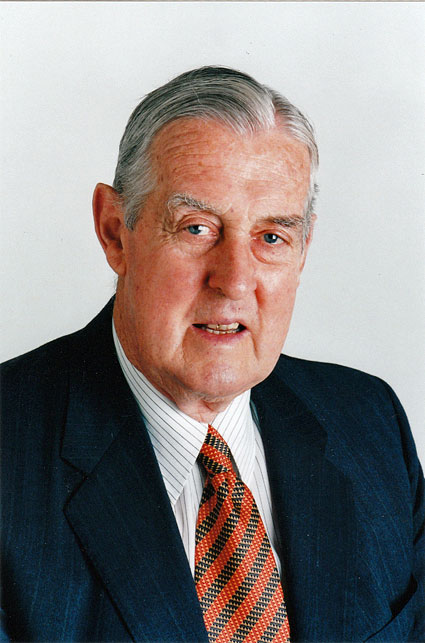GEORGE BOWRING FINCHAM
ORGAN BUILDER AND PROPERTY INVESTOR
31-3-1917 – 19-5-2008
By John Maidment OAM

Photo: David Fincham
The esteemed Australian organ builder George Bowring Fincham passed away last May in his 91st year. He was the only son of Leslie Valentine Hunter Fincham and his wife Ruby Kathleen, née Bowring, and the grandson of the founder of the firm George Fincham – a remarkable three-generation gap of 180 years. The Fincham family had been organ builders in Britain since the 18th century and he continued and developed this worthy tradition.
Educated at the Hawthorn West State School and Melbourne High School (which he was obliged to leave at an early age owing to the Depression), he paid his first business trip for George Fincham & Sons Pty Ltd to Tasmania in 1933 and was appointed company secretary and public officer of the firm in July 1934. He had applied for a RAAF cadetship but this was cancelled owing to his father’s sudden ill health. In 1941 he was sent to the Officer’s School at Seymour and was promoted to the rank of Captain in the Australian Army, serving with distinction off the Western Australian coast.
Following his return from war service, G.B. Fincham was appointed managing director of the Fincham firm in 1947 - his father was then almost 70 years old. With excellent managerial skills, he quickly built up the firm to a position of leadership in the Australian organbuilding industry. Electro-pneumatic actions were introduced as standard practice (the firm had previously being using the obsolete form of tubular-pneumatic action since the 1880s) and components were sought from leading suppliers nationally and overseas (such as the Tamburini firm in Italy) to produce a well engineered and highly durable product. The services of distinguished English voicers Cecil Way (from J.W. Walker & Sons) and Stephen Laurie (from the John Compton Organ Company) served to enhance the quality of its work in the 1950s.
The post-war period was one of great demand for Australian-built pipe organs. When raw materials were short, G.B. Fincham used well-seasoned parts of older organs such as the 1880 Exhibition grand organ built by his grandfather which his firm dismantled in 1948. The firm responded to the need for pipe organs by producing a considerable number of successfully conceived and built instruments on the ‘extension’ principle that utilised a small number of pipes to produce a broad range of stops. Many of the major organs in Victoria and Tasmania were also rebuilt by the firm at this time such as the instruments at Scots’, The Independent and Wesley Churches in Melbourne, Wilson Hall, at the University of Melbourne, and St Kilda Town Hall. G.B. Fincham’s work could be found in four Australian states. Preservation of older organs through sensitive restoration was not then part of the firm’s philosophy (as in most other firms too) and this had to wait until the 1980s and 1990s in the work of his son David who took over as Managing Director of the firm in the 1970s.
The culmination of G.B. Fincham’s organ building career was reached in 1964 with the opening of the new four-manual organ at St Patrick’s Cathedral, Melbourne. In the Herald (Melbourne) on 12 July 1962, George Fincham stated that the new organ “will have life and color in its tones – none of this heavy, muddy traditional stuff”. This was the largest organ built by the firm since its instrument for the 1880 Melbourne Exhibition. At this time the firm had a workforce of 19 staff. George boasted at the time that he didn’t have a single organ recording in his collection: his extra-mural interests were more concerned with sailing yachts.
G.B. Fincham also exercised considerable skill in the development of a large property portfolio. Conscious of the difficult financial situation faced by Australian organ builders in the inter-war years (the Fincham firm had a permanent overdraft operating during the 20s and 30s), he was able to acquire land and develop properties that guaranteed a regular source of additional income that was not dependent upon a regular flow of contracts. In recent years he endowed a scholarship at his alma mater Melbourne High School that perpetuates the family name. In 2006 the organ building premises in Stawell Street, Richmond was sold by the Fincham family, thus severing a link of almost 150 years to this site.
George married Marjorie Bond in 1941 who pre-deceased him last year. They are survived by their two children David and Susan.
John Maidment OAM is Chairman of the Organ Historical Trust of Australia